posted 11 years ago
As with so many skills and crafts, there are lots of layers to this one. From a standpoint of self-sufficiency, you would need to begin with slaughter and skinning, because leather is just a cured/preserved form of animal skin. So the first step and skill is getting the skin from the animal. The next is tanning, or otherwise preserving. At is, you could opt for rawhide rather than tanning into leather, or you might go with taking rather than tanning or rawhide. Multiple choices and so far you only have a raw skin.
Scraping and salting the hide preparatory to tanning. Hair off or on? Depends on intended use and a choice to make before tanning. Tanning choices: brain tanning; vegetable tanning, for two. Vegetable tanning - what materials work? Plants loaded with tannins, oak, sumac, to name only two. Stretching and breaking - tanned leather can be stiff as a board and requires "breaking" to make it into a supple material.
Just getting to the point where you have workable leather is its own industry.
Now you have a hide. What is it good for? Different animals produce very different leather. Kangaroo is phenomenally tough. Deer is soft, supple and stretchy. Cowhide runs a gamut from thick to thin, strong to weak, stiff to floppy and it stretches. Horse does not stretch, has really tight grain and is remarkably durable. What to use for which jobs? Another area of understanding and expertise. Goat has been highly prized for bookbinding for centuries. Horse makes excellent straps (remember the not stretching part). Kangaroo is the material for good hockey gloves, which might suggest some other uses. Cow is versatile and commonly available today. General utility leather, it gets used for everything from horse tack to clothing for people.
Being able to select appropriate hides for given jobs, another skill set.
Animal harness is a good practical homestead skill set, from a bridle for a horse to a cart harness for a goat. Building a bridle for a horse would be a good practical project to demonstrate several skills. You have to understand how a bridle works, layout and cut the pieces, properly finish the edges, glue and stitch to assemble, including mounting buckles, apply appropriate finishes and sealers.
Then there is jackware, the category of leather bottles and drinking vessels. Another and, IMO, more advanced set of skills involved in wet forming and then waterproofing with wax.
Have not touched on all the decorative arts associated with leather working, again, their own entire craft. Tooling, with stamps, with knives, with both in combination, with or without stains, dyes or paints.
Basic functional skill set for a person to work with leathe without having to actually make it in the first place: know how to evaluate leather for a given purpose; know how to mark out a pattern for cutting; be able to cut to the pattern; know how to finish the edges (important for the durability of the leather, not just appearance); know how to do a saddle stitch with double needles; know how to mount buckles; know how to finish leather and what finishes for what leathers and what purposes.
If you have those, then you can make everything from working animal harness to a belt to hold up your pants to a protective apron for your blacksmith to a wallet or a purse.
Shoes gets you into yet another craft, but the basic skills of cutting to pattern, finishing edges, sewing (oops, this gets you into whole new kinds of stitching), finishing will serve in good stead in shoemaking.
Decorative arts for leather: pattern transfer (different from marking a pattern for cutting); incising the pattern with a knife (swivel or straight); use of stamps, either to accentuate and develop the incised pattern or on their own to create stamped patterns;staining, dying or painting. Transferring a pattern and then incising, stamping and coloring and finishing would be the demonstration piece here.
You can combine elements - a tooled western saddle is generally recognized as the ultimate expression of the leather worker's skill set. Functional, comfortable and beautiful, it is proof of a mastery of the craft.
Simple to get started in leather working, you just need to be able to cut according to the pattern and sew the pieces together as instructed. These are not particularly difficult things to do. Getting good at them, that can take you a while.

 1
1






 2
2






 1
1










 1
1








 And that is fine. But I mean a literally diferent place, as well as figuratively. In my suburban location, just getting my hands on a fresh hide would be a headache. Going through the process of tanning a hide where I live could get me in trouble (ok, more trouble) with neighbors and the township. I am pretty certain tanneries are not permitted here. Tanneries are the first industry to be banned by zoning ordinances, which I think says something about having one around
And that is fine. But I mean a literally diferent place, as well as figuratively. In my suburban location, just getting my hands on a fresh hide would be a headache. Going through the process of tanning a hide where I live could get me in trouble (ok, more trouble) with neighbors and the township. I am pretty certain tanneries are not permitted here. Tanneries are the first industry to be banned by zoning ordinances, which I think says something about having one around  .
.
 . Yes, shwoing the connections is critical.
. Yes, shwoing the connections is critical.

 1
1














